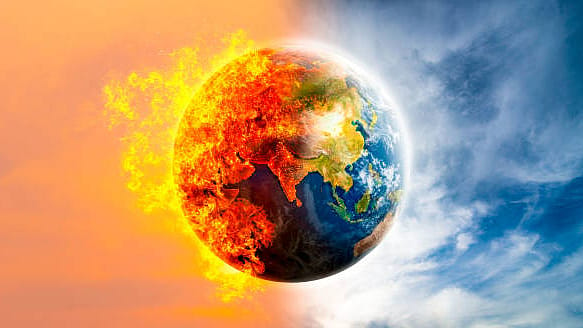Global Heat & Cooling Forum: Why urgent action on rising temperatures can’t wait, as per experts
ADVERTISEMENT

The year 2024 has been the hottest year on record till date, and 2025 is projected to be even hotter. Let that sink in. As the world grapples with escalating temperatures, the need for urgent and integrated solutions has never been greater. The Global Heat & Cooling Forum: Solutions for a Warming World, organised by Natural Resources Defense Council (NRDC), brought together policymakers, experts, and industry leaders to tackle one of the most pressing climate challenges: the rising demand for cooling in an increasingly hot world.
“Heat stress is a silent crisis reshaping our economy, our health, and our communities. We cannot afford to look away,” said Dr Chandra Sekhar Pemmasani, hon’ble minister of state for rural development and communications, government of India,. Drawing from personal experience, he recounted the challenges of campaigning during India’s sweltering summer, an ordeal that exposed him to the brutal effects of heat firsthand.
The impact of extreme heat extends far beyond discomfort. Heat waves have claimed over 11,000 lives in India since 2009, making them the country’s deadliest natural disaster after cyclones. By 2050, over 200 million Indians will be directly affected, with a projected GDP loss of nearly 4.5% due to decreased productivity among outdoor workers.
December 2025
The annual Fortune 500 India list, the definitive compendium of corporate performance, is out. This year, the cumulative revenue of the Fortune 500 India companies has breached $2 trillion for the first time. Plus, find out which are the Best B-schools in India.
“Access to cooling remains a major inequality issue. Cooling is no longer a privilege—it is a fundamental right,” Dr Pemmasani emphasised, urging a shift towards affordable and sustainable cooling solutions.
From policy to implementation
Recognising the challenge, the Indian government has taken decisive steps. Dr. Pemmasani highlighted India’s role in developing the India Cooling Action Plan (ICAP)—the first comprehensive framework of its kind globally. The plan promotes energy-efficient cooling systems, phases out harmful refrigerants, and prioritises vulnerable communities.
Beyond policy, the Ministry of Rural Development has embedded climate resilience into its flagship programmes. The Mahatma Gandhi National Rural Employment Guarantee Scheme (MGNREGS) has supported climate-adaptive infrastructure, including water conservation systems and shade plantations. The Jal Jeevan Mission aims to provide sustainable drinking water, mitigating the deadly combination of heat stress and dehydration.
“Innovation in housing is also key,” he said, citing the Pradhan Mantri Awas Yojana-Gramin (PMAY-G), which has provided 30 million climate-resilient rural homes since 2016. The government’s latest initiative, SHIELD (Sustainable Housing, Integrating Efficient Living and Disaster Resilience), in collaboration with the World Bank, integrates climate-adaptive designs into rural housing. Moreover, the Government of India has allocated $30 billion over five years (2021–2026) for disaster mitigation, including heat-related programmes. In 2023–24 alone, $850 million was approved for mitigation efforts, focusing on landslides, lightning, drought, and earthquakes—but not specifically heat yet.
Need for systemic change
India’s rapid urbanisation is exacerbating the crisis. Arvind Kumar, Special Chief Secretary (Disaster Management), Government of Telangana, pointed out that unplanned urban sprawl is pushing millions into precarious living conditions, where tin sheds and asbestos roofing intensify heat exposure.
The National Disaster Management Authority (NDMA) has been driving efforts to address urban heat through heat action plans (HAPs). Safi Ahsan Rizvi, advisor, NDMA emphasised the importance of localised strategies, saying, “A heat action plan must not be another 50-page document no one reads. It must assess risks at the neighborhood level and be owned by local authorities.” India has already developed 200 city-level HAPs, with plans to scale up to 500.
Cooling demand & energy efficiency
On the flip side, India is poised to become the largest growth market for air conditioners in the world. “Every 15 seconds, an air conditioner is sold in India,” said Abhas Jha, practice manager for Climate Change and Disaster Risk Management, South Asia Region, The World Bank. “Yet, 90% of these are energy-inefficient models, and if we don’t act now, this demand will make it even harder to meet global climate goals.”
India currently has an AC penetration rate of just 8%, compared to 90% in China. However, this number is expected to rise rapidly, which could put immense pressure on the power grid and increase emissions. “If we continue on this trajectory, forget about 1.5 degrees—maybe even two degrees of global warming will be off the table,” warned Jha.
To counter this, experts at the forum emphasized the urgent need for energy-efficient solutions. BLDC (Brushless Direct Current) ceiling fans, passive cooling techniques, and urban greening initiatives were identified as key measures. The World Bank’s recent report highlights that urban greening investments and early warning systems offer some of the most cost-effective interventions, with benefit-to-cost ratios as high as 50:1.
Ahmedabad was the first city in the world to develop a Heat Action Plan (HAP), setting a precedent for other regions. Telangana’s green cover has increased by 7% over the past decade, demonstrating how proactive policies can mitigate urban heat.
“Wealthy individuals and nations contribute the most to climate change, yet the poorest communities bear the brunt of its consequences. The ‘heat divide’ is real, and we must act now,” said Manish Bapna, president and CEO of NRDC framing the crisis as a moral issue.
Dr Pemmasani concluded with a call for global cooperation, “Protecting and replenishing natural resources is not the job of a single nation or organisation. If governments, businesses, and communities unite, we can pave the way for a sustainable and resilient future.”
As the world inches towards another record-breaking summer, the message is clear: solutions exist, but action must be swift, coordinated, and equitable. The future depends on it.
